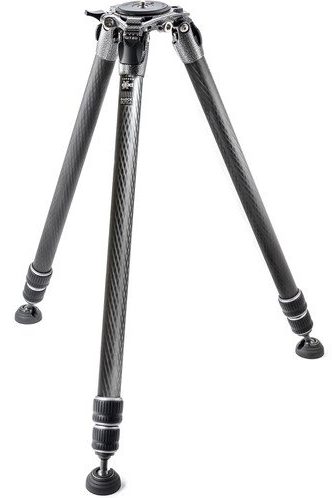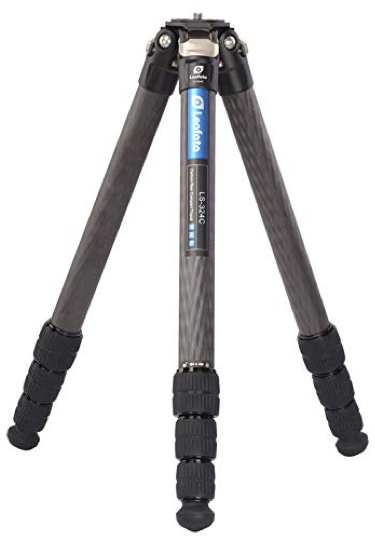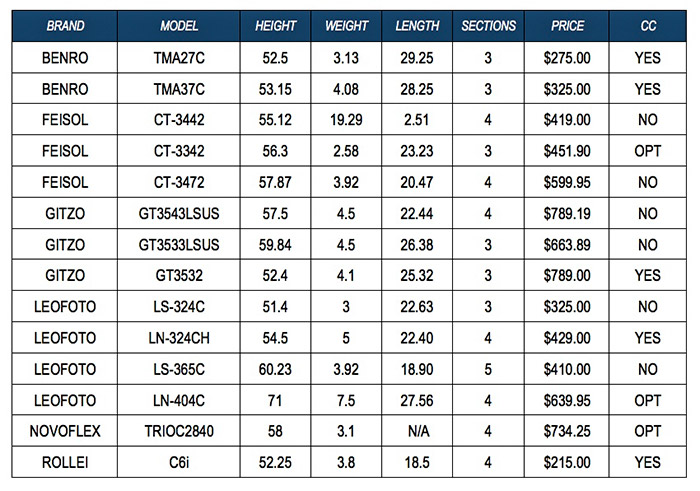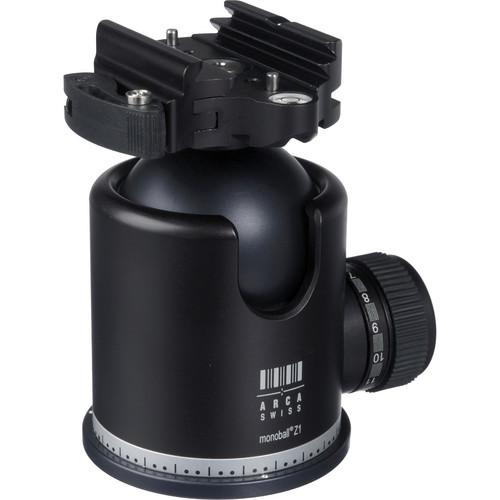With the advent of optical image stabilization my trusty old Leitz Tiltall tripod fell into disuse and remained stashed away in my closet for many years. After all, with image stabilization one can hand-hold and shoot at speeds unheard of in the past, like ⅛ of a second even. Great for shooting from the hip, on the run, in the wild or on the beach, but when I got serious about landscape photography (again) I realized I needed a new tripod, something lightweight and easy to work with—my old Tiltall weighs over 6 lbs. I was leaving soon to photograph the fall colors in Vermont so I had to act quickly.
I have to admit that I didn’t know a lot about the new, modern tripods, except that carbon fiber was one of the important advances in tripod technology and that was my first requirement. I didn’t want to spend $1000 on a tripod but I’ve always known that you have to spend a lot to get a really good one. Well, I fell prey to modern marketing and bought a Rollei C6i 4-section carbon fiber travel tripod that came with a ball head and weighed only 3.8 lbs. with the head. It was a Rollei so it had to be great. After all, I had had Rollei cameras back in the film days and they were some of the best. And it wasn’t that expensive at $229.
I received it and took it on my trip and used it extensively for 5 days, and it served me well for that short period of time. But, I was disappointed when I met a half dozen amateur photographers with nearly identical tripods to mine with off-brand names; they had paid almost half the price. It turns out there is literal flood of almost identical tripods on the market, and the name Rollei was just a marketing ploy.
Now, to be fair it’s not a horrible tripod by any means, it’s actually quite good especially if it can be had for less than $200. With a better, more professional head it would work okay as a hiking or travel tripod. My criticism would be that it is a bit flimsy, and perhaps too lightweight, with very thin legs; it has a center column because fully extended it is nowhere near tall enough for me without it; and, the ballhead is junk—difficult to adjust and not big enough to safely hold any large heavy lenses. Still, this was my first foray into the world of tripods in over 40 years so I had a lot to learn.
Upon my return from Vermont I decided to buy the perfect tripod and ball head and now that I had some time I really dove into it. Here’s what I wanted:
- Somewhat lightweight—under 5 lbs.
- Tall enough to not need a center column—54” or taller for my 5’11” height
- Thick enough legs (32mm or more for the top section) for stability
- 3-Section for more stability and to make it easier to put up and take down
- Or 4-Section for shorter folded length for travel
- Quality build and materials
- Great reviews from other photographers
I made a spreadsheet listing various possibilities, including a few that got great reviews but didn’t necessarily meet all my other requirements. I wanted to make sure I considered the best ones out there for under $900. I included the Rollei for comparison. Keep in mind the prices listed are what these tripods were selling for at the beginning of 2019. There are many other fine tripods from other brands such as Really Right Stuff, Induro, FLM and ProMedia Gear to name a few, but I wanted to keep the cost down and I wanted to see if any of the less expensive brands were up to snuff. With modern materials and mass manufacturing in China, it seems reasonable that lower-priced tripods could be quite good. Most photographers will have their favorites and an opinion about which brand and model is best, but this is what I came up with for starters, priced from $275 to $789. Unless you’re a pro and can only have the best, a tripod in that price range should suffice depending on your needs.
The above list covers a pretty wide range of prices and sizes and includes a few with center columns and others that you can add a center column to. I really don’t recommend a center column, but if you are determined to have a tripod with a center column I recommend buying one that has an optional center column that you can install when needed.
Let’s talk about weight. If you’re young and buff, or old and buff, and carrying a heavy tripod with a heavy camera and lens attached isn’t going to phase you, then your choices are less limited. One good choice would be the Leofoto LN-324CH at 5 lbs. for around $365. You will not be disappointed in Leofoto’s quality—don’t let the price fool you, they are seriously as good as Gitzo in every respect.
If, on the other hand, you’re not up to carrying a heavy load, or you just don’t want to, or maybe you’re carrying other gear as well, then weight is pertinent and you really want to keep the weight of the tripod (by itself) below 4 lbs., or less. You will notice that the three lightest tripods listed are Feisol. They are unbelievably lightweight for their size. They get great reviews and are well made. However, I feel that the lightest ones aren’t heavy enough to be stable in the wind or on uneven and rough ground. But, for a hiking tripod, you really can’t go wrong with Feisol.
Let’s talk about height. I admit to being a bit confused as to what I wanted in the height of a tripod. At first I thought I wanted one that when fully extended, with head and camera mounted, would bring the view finder right about to eye-level. This turned out to not only be difficult to fulfill, but unnecessary for several reasons.
For one, when the viewfinder is at eye level you can’t see the top of the camera if you like to look at the LCD display, and it’s difficult to see your subject without craning your neck or looking around to one side. Better, in my opinion, to have the viewfinder a couple 2-3 inches below eye-level. The problem is, once in a while you need a taller tripod, especially if you’re shooting the night sky or standing on the bank of river with the tripod in the water. Better to have one that is too tall than not tall enough. The one I wound up buying is almost 60” tall when fully extended.
And that is too tall when fully extended with ball head and camera attached, so what I have done is this: I extended the legs out all the way and then using a tape measure I retracted the lower section of each leg until it brought the height exactly to where I wanted it. This took some experimentation. Then I took a permanent marker and made a line on each leg at the twist lock of the lower section. Now when I extend the legs I just bring the lower section of each to that mark and the tripod is level and at the right height. This can be repeated at for different pre-set heights. Better too tall than too short.
For this tripod I wasn’t too concerned about the folded length, but it is an important consideration if you are hiking or traveling and want to fit the tripod in a backpack or suitcase. For that you will want a tripod that folds up to 16”-18” or less. Keep in mind that tripods that fold up that small are not going to be very tall when you fully extend the legs. That’s when you want a 4-section tripod or even a 5-section. I was looking for a tripod I could throw in the trunk of my car and take out and set up nearby or within a reasonable walking distance of a few hundred yards, so the folded length wasn’t an important parameter.
Let’s talk about leg thickness, strength and quality. It varies a lot amongst tripods of the same height. I determined that a tripod with a 32mm or greater upper section was going make the tripod more stable. The lower sections are then also pretty thick, depending on how many sections there are. Of course the lowest section is going to be the thinnest and a 4-section tripod’s lowest section is going to be thinner than the lowest section of a 3-section tripod, which is why a 3-section will be a little more stable. Maybe I’m splitting hairs, but when I mount $5,000 worth of camera and lens on a tripod I want it to be stable.
As far as strength goes, I think even the lightest carbon fiber tripods can bear a great deal of weight, more than most cameras and lenses weigh, but if you are going to be using a long heavy lens, like 600mm Nikkor, you will want the strongest tripod you can get.
As for quality of construction and materials, I can highly recommend Gitzo and Leofoto. Feisol is also well-made, but not as heavy duty, that’s why they are so light weight. What I looked at very closely was the top plate, the twist locks, and the legs. The better tripods have legs that have anti-twist technology and don’t twist when you go to lock them, including the lowest section that on cheaper tripods do turn.
The Gitzo GT3533LSUS (same thing as the GT3533LS) is the winner, mainly because I found it on sale for about $200 less than the regular price of $859. It is one of the Systematic models, Gitzo’s pro tripods. Like most people, I love a bargain, and that is a bargain. And after all, the Gitzo name has panache. Had I not found it at that price I would have bought a Leofoto LS-365C.

This Gitzo wasn’t on my original list but I checked its specs and read many reviews. Its weight is at the top of my range at 4.5 lbs., but that is acceptable; it’s 59.8 inches—on the tall side, but that’s okay too. It is as every reviewer says, well-made, very stable, and at 4.5 pounds, it’s heavy but not too heavy— I can handle it. I marked the bottom leg sections as mentioned above to make it easy to set up at the right height for level ground. It’s a beautiful tripod and I am confident it will last a lifetime. After trying very hard to avoid Gitzo it’s the one I wound up with in the end.
Now for a ball head to go with it. There are so many excellent ball heads it wasn’t going to be easy and it would require a lot of homework. After trying seven different heads, including a Novoflex MagicBall 50, a Leofoto LH-55, and a Sirui K-20X, it came down to four: the Really Right Stuff BH-55 with lever clamp, the Arca-Swiss p0 Monoball with lever clamp, the Acratech GP with lever clamp, and the Novoflex Classic Ball 5-II with an RRS clamp. A tough choice!
The RRS BH-55 is beautifully made, smooth and heavy duty—it can handle the biggest and heaviest cameras out there, up to 50 lbs. Its low-profile design keeps the height down which helps for several reasons, one of which is fitting it in a tripod case. It’s everything everyone says it is and certainly one of the very best ball heads ever made. Made in America.
The Arca-Swiss p0 Monoball with FlipLock Lever Clamp is almost the opposite of the RRS—it’s small, light and innovative. A really right Swiss design, it is elegant and very well made. Gone are the big knobs. The ball is tightened via a ring that also adjusts the drag. A small lever controls the panning. It’s not just a ball head it’s also a panorama head, since the ball is on the bottom not on the top and it is very easy to level and take a full panorama without turning the head upside down or adding a panorama base. It’s all there and it works really well. Perfect for both travel and full-size tripods alike as it can handle 44 lbs. Made in Switzerland. I have to say the FlipLock lever clamp is not as easy to use as the Acratech or the RRS clamps, but once you’re used to it you will find that it is extremely secure.
The Acratech GP with Lever Clamp, while still somewhat conventional, is innovative in its execution: the ball is open, not enclosed in a neoprene-lined socket. It still has knobs but they are knurled and easy to grab without mistaking one for another. Well-made in America like the RRS, it is also a thing of elegant design. It features a “gimbal” feature that allows for movements similar to a gimbal head, but I found that to be totally useless since the camera is off to one side of the tripod center. A more useful feature is it can be converted to a panorama head by removing the clamp and turning the head upside down on the tripod, replacing the clamp on the bottom that is now the top. Why not just leave it in pano mode upside down? Still, it is an excellent head and will last for many, may years, especially since it has a 10 year warranty.
The Arca-Swiss Monoball Z1+, a superb, smooth, easy to work with and heavy-duty while also very light ball head. I highly recommend this ball head over all the others.
A review of the Arca-Swiss Z1+ from a buyer on B&H: The best ball head on the market today. I had the RRS BH-55 and the Markins before but this one is better (and cheaper) than any of these two. The RRS BH-55 has an excellent workmanship but the smoothness of the ballhead does not compare to the Arca Swiss Z1 and also a lot bulkier. The Markins is very smooth but the aspherical ball head design of the Arca Swiss Z1 has a definite advantage.The Flip-Lock is excellent and the fact that it is user adjustableis a big advantage for different brand of mounting plates. Expertise: Advanced amateur with 40 years experience. Previous Equivalent Item Owned: RRS BH-55, Markins M-10, Arca Swiss B1.
The Novoflex ClassicBall 5-II is last but certainly not least, but it is a beast! It can handle the weight and size of the largest cameras and long lenses. Like the Arca-Swiss P0 it is innovative in that it also does not have any large knobs to deal with, just a lever to tighten the ball.It also has a ring that is used to set the drag friction in indexed steps. It has but one small knob for panning, and this is where it is similar to the Acratech: you can turn it upside down on your tripod and level it for perfect panoramas. It comes without a clamp but Novoflex makes beautiful clamps and you can also choose from other brands as well. The RRS B2-LR-II Lever Clamp is a perfect match.
Don’t worry too much about the weight capacities for the heads, if it can handle 10lbs. it will be more than you need. Most sturdy tripods can handle more weight than you will put on them, but the more the better to a point and that point is where the tripod itself weighs too much to work with, unless you’re shooting with something like an 8×10 studio view camera.
So which one did the fountain choose? To top off the Gitzo Systematic I chose the Arca-Swiss Monoball Z1+. Why? I needed a head that can handle my Nikon D850 with the Tamron 150-600mm lens. While the RRS could easily handle it as well, I really didn’t take to the extra large knobs. The Arca-Swiss had no problem with it. The Acratech is also quite capable but isn’t as smooth and as easy to lock as the RRS or the Z1+.
Let’s not stop there, though. The Gitzo Systematic and the Arca-Swiss Z1+ are superb, but they are also pretty heavy when stuck together, a total of 6.5 lbs., which is fine for most shooting, especially wildlife and landscapes, as long as I don’t have to carry it a couple miles up a mountain trail. For that and for any traveling, I decided I needed a second tripod, smaller, lighter, but of the same quality. That would be the Leofoto LS-324C.

Weighing in at 3 lbs., 22.6 inches when folded and 51.4 inches tall, it’s well made, sturdy and stable. Coupled with the Arca-Swiss p0 Monoball, it weighs under 4 lbs., and it is a dynamite combination. The 2½ pound difference is a big difference on a hot day and a steep hill. It is quick and easy to set up, light and easy to carry with a heavy camera and lens, and it can handle the D850 and all my lenses, even the Tamron 150-600mm in most situations. It just may see more action than the Gitzo. The Leofoto comes with a perfect case that fits the LS-324C with the Arca-Swiss head, and it has a nice accessory pocket on the outside for additional clamps and such.


